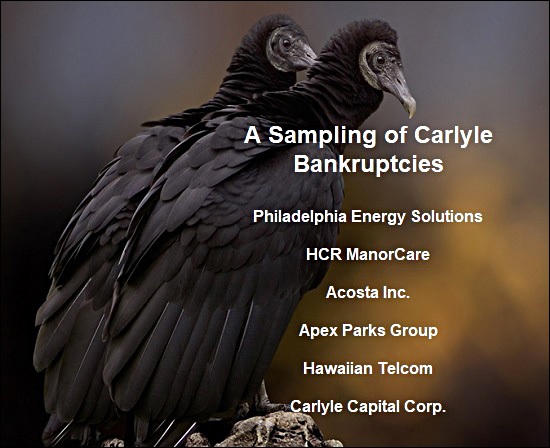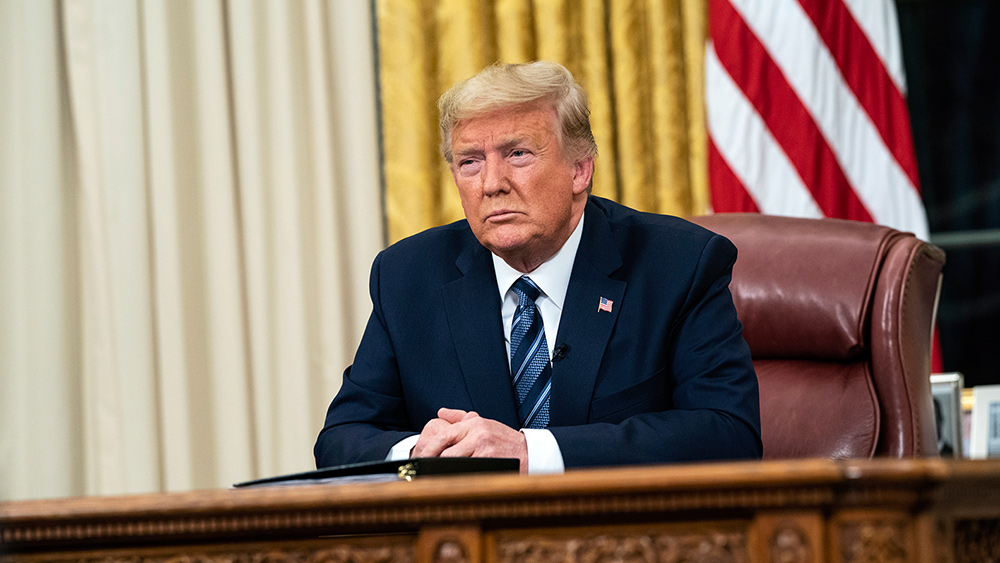The Fed’s Chair and Vice Chair Got Rich at Carlyle Group, a Private Equity Fund with a String of Bankruptcies and Job Losses

By Pam Martens and Russ Martens: May 18, 2020 ~
Private equity funds have been variously called “merchants of debt,” “vultures,” or “corporate raiders.” What a private equity fund typically does is to buy up companies by piling debt on the balance sheet, selling off valuable assets like real estate, extracting giant dividends for the private equity partners to the detriment of workers and customers, and then, frequently, letting the company collapse into bankruptcy while laying off thousands of workers or liquidating the whole company.
It should give pause to every American that the two top men at the Federal Reserve who are implementing a new $4.54 trillion bailout fund for Wall Street, using $454 billion from taxpayers to absorb the losses, both got rich working for one of the world’s largest such private equity firms: the Carlyle Group.
According to his official bio, Fed Chairman Jerome Powell was a partner at the Carlyle Group from 1997 to 2005. In November 2017, Stephen Gandel, writing for Bloomberg News, calculated that Powell’s wealth could be as much as $112 million.
The man responsible for supervising the largest and crime-riddled banks on Wall Street, Fed Vice Chairman for Supervision Randal Quarles, is even richer than Powell. According to Quarles’ financial disclosure form dated June 1, 2017, he could be worth as much as $125 million. In 2017, between $10 million to $50 million of Quarles’ investments were in Carlyle Group. On just those Carlyle investments, Quarles was receiving a range of between $2 million and $10 million in annual income. (The government allows federal employees to report a preposterously broad range on asset values and income on financial disclosure forms.) Quarles was a Managing Director at Carlyle Global Financial Services Partners from 2007 to 2013. The Carlyle investments have been replaced by different investments on Quarles’ most recent financial disclosure form.
Carlyle Group’s current and former partners are not defensive about the string of bankruptcies and jobless workers it has left in its quest to extract riches from its buyout targets. Carlyle had several bankruptcies during the last financial crisis with more blowups in the past two years.
In November 2018, Peter Whoriskey and Dan Keating of the Washington Post penned a devastating critique on how Carlyle had handled its investment in a chain of nursing homes known as HCR ManorCare, which filed for bankruptcy in March of 2018. The authors wrote that there was a 29 percent rise in serious health code violations at HCR ManorCare in the years before the bankruptcy and following a 2011 financial deal that “extracted $1.3 billion from the company” for Carlyle investors while saddling the nursing home chain with debt. Under the same deal, most of the company’s real estate was sold off, forcing it to now pay rent to the new owners. Hundreds of layoffs of employees occurred soon after, leaving the vulnerable residents neglected according to the article.
The Washington Post reporters explained the consequences of leveraged-buyout artists running homes for the most vulnerable in society:
“The lack of care had devastating consequences. One man had been dosed with so many opioids that he had to be rushed to a hospital, according to the inspection reports. During an undersupervised bus trip to church — one staff member was escorting six patients who could not walk without help — a resident flipped backward on a wheelchair ramp and suffered a brain hemorrhage.
“When a nurse’s aide who should have had a helper was trying to lift a paraplegic woman, the woman fell and fractured her hip, her head landing on the floor beneath her roommate’s bed.”
In January 2018, another asset-stripped company that was owned by Carlyle Group, Philadelphia Energy Solutions (PES), filed bankruptcy. Reuters explained what happened this way: “The Carlyle-led consortium collected at least $594 million in cash distributions from PES before it collapsed, according to a Reuters review of bankruptcy filings. Carlyle paid $175 million in 2012 for its two-thirds stake in the refiner. More than half the distributions to the Carlyle-led investors were financed by loans against PES assets that the refiner now can’t pay back, the filings show.”



